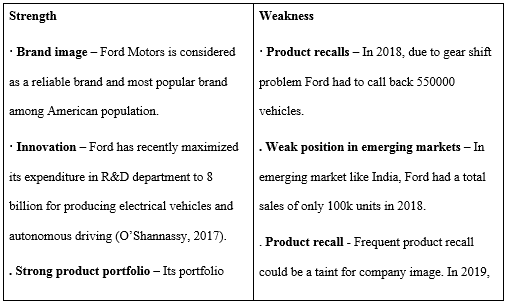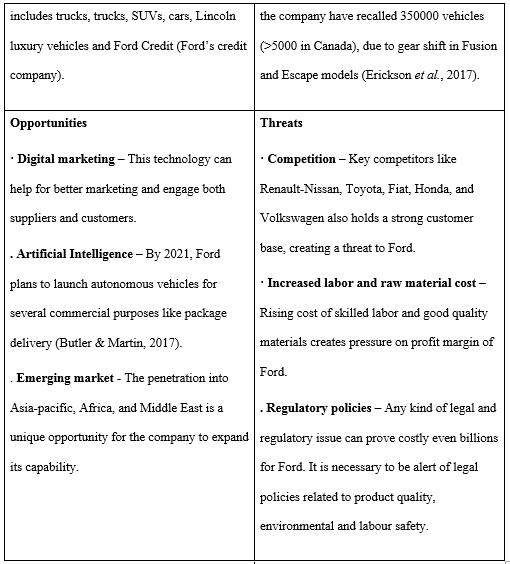Case Analysis of Ford Motors Assignment Help
Identify key functions and skills required of management within an organization. Identify and analyze leadership approaches in a variety of situations. Analyze constrain. managers encounter within the external environment. Identify the steps involved in Inc strategic planning process
Get assured A++ grade in each Case Analysis of Ford Motors Assignment Help solution order – Order for originally written solutions!
Introduction
The success of business operation mainly depends on promoting two major factors which include effectiveness and efficiency. When an organization is involved in manufacturing, retailing, providing services to consumers, the most essential factor that determines the success is internal organization and it's alignment which external environment. This refers to effectiveness in managerial activities, motivating employees, and achieving competitive advantage in market (Summerby-Murray, 2017). The objective of this report is to undertake case analysis of Ford Motors Canada, thereby identifying the management practices, leadership style and strategy framework that helps the company to retain its market image and gain competitive advantage.
Ford Motors Canada: Customer and Mission
Ford motor of Canada limited was founded since 1904, with the sole purpose of manufacturing and selling Ford automotive. The headquarter is located in Oakville, Ontario province and its current CEO is Mark Buzzell. Within Canada, the company have four major location with more than 6600 employees, and is involved in manufacturing of engine, super duty truck, and stripped chassis, as well as assembly of varieties of models available in present market globally (Fetzer, 2017).
Management and organization
The management and organization at Ford motor work with mission of one ford, that consists of one team, working together as global enterprise and lean for automotive leadership; one plan to accelerate the development of new products and improve the balance sheet; and one goal for delivering profitable growth for all (O'Shannassy, 2017). The core value of organization lies in elements such as people, product, profit, and organizational culture which are discussed in this section.
Key functions
The key function of management team is to provide opportunities to their employees such that innovation can remain highlighted in their products. This include radius functionalities such as HR management for selection and recruitment, motivating employees, offering opportunities for growth and development, analyzing market, and developing strategic framework for competitive advantage. Examples to support these managerial functions can be found with respect to good market image for being largest automotive manufacturer since 2006, having strong and globally position brand as highlighted by Fortune 500, effectiveness in business operation which results in 1285% increase in net cash since 2000 (Zhao & Huchzermeier, 2018). In addition to this, Ford Motors is also known for their R&D activities that helps in implementing disruptive technologies according to the customer requirement into their product line.
Managerial skills
Managerial skills which are the core trend to the company include technical skills which helps the manager to retain ability as well as knowledge regarding various techniques for achieving the objectives. These include, but not limited to, operating machine, software, production tool, integration of electronics with automobile, design, marketing, and market forecast. Human interpersonal skill is another factor that helps the managers at Ford Motors to integrate their employees and work for a common objective (O'Shannassy, 2017). Similarly, conceptual skills in terms of abstract thinking and formulating ideas, diagnosing the problem, and finding creative solution helps respective departments to overcome the concerning challenges and retain the competitive advantage in market.
Important remarks for the managerial skills include planning that sets guidelines for effective resource management including labor money and time, effective communication skills, strong and quick decision-making skills, smart delegation practices, and problem-solving skills with respect to market situation (Kaplan & Montiel, 2017). Of note, these managerial skills had the company in effective organizational management, for example in Canada the employment turnover is 4% since 2017 (Yates & Lewchuk, 2017). Similarly, the effectiveness of managerial skills for motivating employees' results into boosting the production of company, which maintains a constant figure call production of about 1000 hybrid vehicle units per year since 2010.
Environmental constraints on management
The most common environmental constraint that were existing on the management team of Ford Motors Canada include, the complicated actions, requirements from legal and social perspectives, economic consideration, and technological up gradation. These facts are important for the conduct of business because for example legal constraints imeplement the policy measures of Health and Safety Act 1974, for the safety measures of employees at their units. The corporate social responsibility and social contraint are depicted with actions related to brining vehicle effectiveness for automotive usefulness in community life, the social corporate responsibilities, and action for carbon footprint to reduce pollution. However, according to Kaplan & Montiel (2017), Ford Motors always adopted the anticipatory approach in which then manages their policies and practices according to the suitability of community well-being and environment; and not adopting the reactive approach to respond for consumer demands, changing economic and technological requirement, and actions of competitors.
Management constraints encountered within external environment
The legal constraint were effectively managed at Ford Motors, such as implementing the Health and Safety at work Act 1947 policies to ensure safety of employees. Likewise, they also invested $200 million for integrating electronic features that offer safe driving to their consumers (Bailo et al., 2018). The technological constraint were maintained by implementing three-wet in technology which is less expensive and reduced CO2 emission as well as reduced emission of volatile organic compounds by 10%, thus achieving solutions to global pollution and warming. The economic and social constraint where managed by using the outsourcing opportunities, especially from the developed countries like India, Mexico, and China (Yates & Lewchuk, 2017). This outsourcing objectives include collection of raw material, manufacturing of electronics, achieving reduced-cost labor, and software development. As a result of which, the company manages to reduce the manufacturing cost from $280 million to $400 million since 2015 to 2017. In addition to this, the outsourcing opportunity also provide employment scope for employees in these nations. The environmental factor related to competitiveness was managed by the company, with penetration into fast-growing and newly developing market such as in Asia-pacific region, Middle East, and African region (Bailo et al., 2018).
Leadership
Leadership is considered as one of the core competency for Ford Motors, which aims to return the experienced employees within organization, motivate their employees to bring innovation, and develop quick decision making skills among managers to convert the market fluctuation into favorable results.
Identification of leadership style
Under Bill Ford's leadership at Ford Motors Canada, practices internal leadership to manage critical components and building motivation for the workforce as well as using transformational leadership style to build public relationships as well as promote branding (Hackett, 2016). The primary form of leadership at Ford Motors included Democratic style, which is also known as shared leadership or participative working attitude. This refers to the procedure where all the team members take active participation in the decision-making process. Another important form is the transformational leadership have the objective to create positive change and valuable perspectives. This leadership aims to generate loyal customers as well as to create potential among the employees, to develop as future leaders for the organization.
Analysis of leadership approach in various situations
As mentioned in the previous context, the company actively seeks outsourcing opportunities to reduce the manufacturing cost as well as to be the capacity for reducing the selling price of alternatives. This gives a clear indication of the strategies adopted by the company to gain cost leadership. Moreover, the company also actively engaged investment into R&D sector such that the disruptive technologies can be integrated in hybrid vehicles, to meet customer requirements as well as to achieve relevant positioning in market; by using technological leadership in competitive market (Hackett, 2016).
According to Venkatarman et al. (2018), transformational leadership plays a critical role in building market reputation of the company. For example, the strategy developers at Canada, understand that their democratic leadership cultivated between investors, suppliers and internal communication will not be enough to ensure survival of company in future market.
Planning and strategic management
Important points included within the scope of planning and strategic management framework include, opportunities of global expansion, retaining financial position in market, maintaining customer loyalty, and introducing hybrid vehicles with fuel efficient engines to attract new customers. In addition to this, other framework include techniques to reduce CO2 emission, reusing the components of car, and reducing the operational cost by making use of outsourcing opportunities (Venkatarman et al., 2018).


Steps involved in strategic planning process
The strategy forces which are significantly high for Ford Motors include internal revelry, supplier power, and entry and exit strategies in market of Canada and US. On the other hand compliments such as fuel prices, road condition, and traffic rules also impact the strategic lines. For example since 2015 the company begin transitioning its manufacturing strength from SUVs and trucks to hybrid cars. The least strategic significant elements include buyer power and substitutes. With buyer power it includes dealership negotiation, concession in selling price, and cost for dealership in limited geographical regions. the financial profitability and growth of Ford Motors indicate that this strategy planning helps in achieving in net income gain of $2.41 per share for the financial year 2015 (O'Shannassy, 2017).
Conclusion
In summary, the present report illustrates research on managerial, leadership, and strategy framework of Ford Motors Canada. The research analysis shows how the company manages effective leadership for motivation of workforce, bringing implementation in hybrid vehicle design, and gain net profitability based on the strategy planning. Future strategies include penetration into is he a Pacific, Africa, and Middle East market that can expand the capabilities of Ford motors. Furthermore it is also realized that the company needs to continue the introduction of disruptive technologies into hybrid vehicles to retain its competitive advantage.
24/7 Availability of Trusted Case Analysis of Ford Motors Assignment Help solution Writers! Order Assignments for Better results!